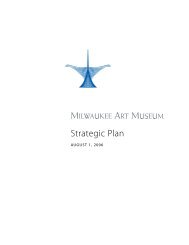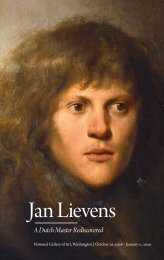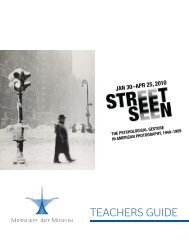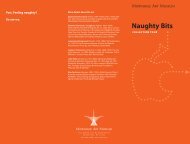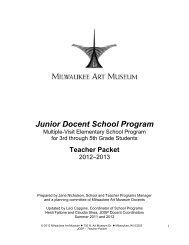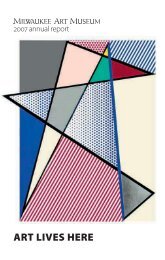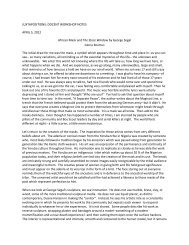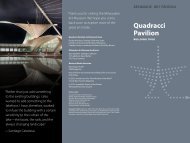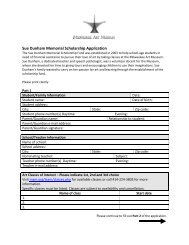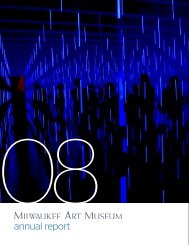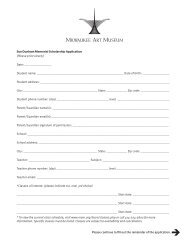Junior Docent School Program - Milwaukee Art Museum
Junior Docent School Program - Milwaukee Art Museum
Junior Docent School Program - Milwaukee Art Museum
Create successful ePaper yourself
Turn your PDF publications into a flip-book with our unique Google optimized e-Paper software.
Chronological Organization<br />
Settlement to Statehood (1634 to 1847)<br />
1634 French explorer Jean Nicolet, the first European in WI, crossed Lake Michigan and<br />
reached the site of present-day Green Bay and met the Winnebagos (Ho-Chunk).<br />
1673 Father Jacques Marquette and Louis Joliet travelled the St. Lawrence River, through the<br />
Great Lakes, and down the Mississippi River.<br />
1718 French settlers built a fort at Green Bay.<br />
1763 British defeated French: WI became part of British territory under the Treaty of Paris.<br />
1825 Opening of Erie Canal increased settler migration to WI.<br />
1846 Solomon Juneau was elected the first mayor of <strong>Milwaukee</strong>.<br />
Comments and Questions<br />
Who were the first people in Wisconsin? The Indian tribes who lived here prospered as<br />
hunters, gatherers, and trappers. What Indian names do you know?<br />
o <strong>Milwaukee</strong> comes from a Chippewa word meaning “gathering of waters”.<br />
o Other Indian names of towns and cities are Waukesha, Oconomowoc,<br />
Pewaukee, Okauchee, Shawano, Tomahawk, Winnebago, Kickapoo,<br />
Manitowish, and Poynette.<br />
o What were the names of the Indian tribes who lived here? In the early 1600s –<br />
Winnebago, Dakota, and Menominee. Others came later – Chippewa, Sauk, Fox,<br />
Ottawa, Kickapoo, Huron, and Potawatomi.<br />
What was the land like? The geography? We need to recognize the importance of Lake<br />
Michigan and Lake Superior, of the other inland lakes and rivers such as the Mississippi<br />
on the west, because these waterways provided the key transportation networks for<br />
Indians, French trappers and traders, missionaries, and later immigrants.<br />
Who was the first European to come to Wisconsin? The first European was probably<br />
Jean Nicolet, a Frenchman who in 1634 was seeking a northwest passage to China.<br />
When he stopped in Green Bay, he dressed in mandarin robes before he went to meet<br />
people he hoped were Chinese. Wisconsin was a frontier province of New France for<br />
100 years. What French names do you know? Marquette, Fond du Lac, La Farge, Lac<br />
du Flambeau, La Crosse, and others.<br />
What did the first Europeans want to do in Wisconsin? Some Catholic Jesuits came as<br />
missionaries and others came in order to obtain furs and wealth. Both England and<br />
France wanted to control the fur trade. A British victory in 1763 gave the British control.<br />
<strong>Art</strong>ist Title Location<br />
Allston, Washington Scene in an Eating House Lower Level<br />
Audubon, John James Trapped Canada Otter Lower Level<br />
Bierstadt, Albert<br />
Wind River Mts. Nebraska Territory Lower Level<br />
Eastman, Seth Indian Scalp Dance Lower Level<br />
Goodwin, Richard LaBarre Hunting Cabin Door Lower Level<br />
Tait, <strong>Art</strong>hur F. The Pursuit Lower Level<br />
American Sculpture of Indian Folk<br />
Phillips, Ammi Portrait of a Woman Folk<br />
34<br />
© 2011 <strong>Milwaukee</strong> <strong>Art</strong> <strong>Museum</strong> 700 N. <strong>Art</strong> <strong>Museum</strong> Dr. <strong>Milwaukee</strong>, WI 53202<br />
JDSP – <strong>Docent</strong> Packet



